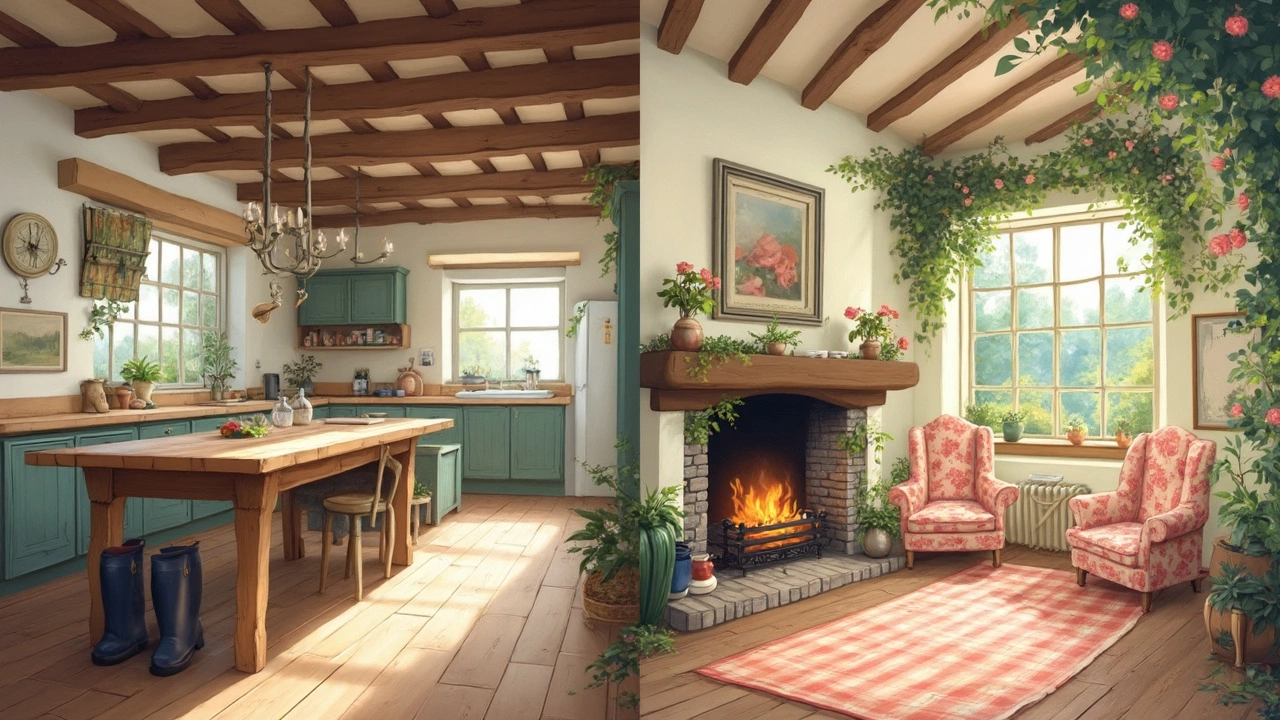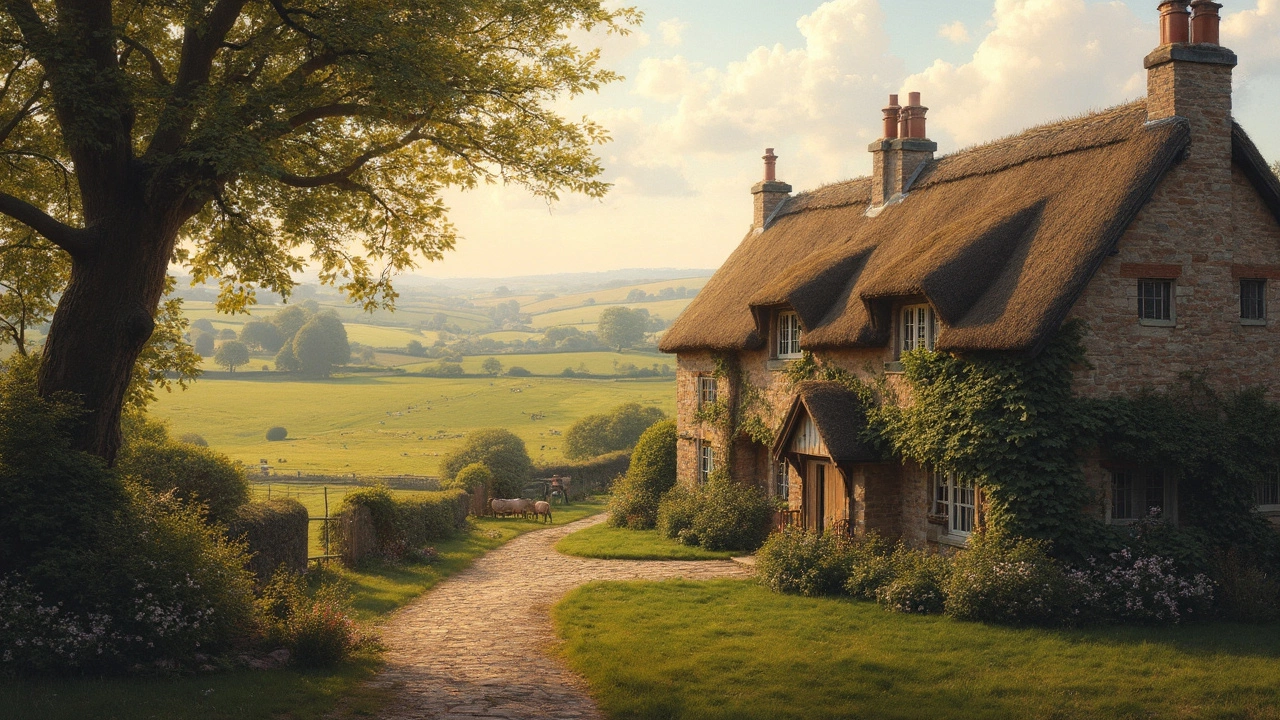Ever found yourself mixing up a country cottage with a farmhouse? You’re not alone—people throw these words around all the time, but they don’t mean the same thing. Right off the bat, here’s the biggie: cottages are usually smaller, super cozy, and sometimes feel like storybook homes, while farmhouses are built for working life, with more open space inside and out.
If you’re house hunting or planning a rural getaway, getting the vibe right matters. Cottages often sit tucked into the landscape, framed by flower beds or climbing roses, showing off charm instead of space. Farmhouses? They’re practical, made for farmers and their families, with bigger rooms and outbuildings for storing tools or housing animals.
Not sure which is which when you’re driving past? Peek at the rooflines and layout. Cottages tend to have lower, sometimes uneven lines and look almost huggable. Farmhouses are all about workspace—think bigger kitchens, central halls, and classic front porches to watch the fields. Knowing these simple contrasts will save you time and help you spot your preferred style in seconds.
- What Defines a Country Cottage?
- Farmhouses: More Than Just Farms
- Design, Size, and Layout Differences
- Which Style Suits Your Dream Rural Life?
What Defines a Country Cottage?
When people think of a country cottage, they often imagine a small, inviting house surrounded by flowers, maybe with a thatched roof and crooked chimney. But there’s more to it than just looking cute. A country cottage is almost always modest in size, often just one or one-and-a-half stories tall. Cottages popped up centuries ago in rural England and were originally worker or tenant homes—not luxury escapes. Many still don’t have giant open floor plans or endless hallways; instead, you get snug rooms and low ceilings to help keep heat in during chilly nights.
Classic country cottages stick to simple materials like stone, brick, or timber. Some of the oldest ones are over 200 years old! You’ll usually spot windows with deep sills (called cottage panes), a front door right off the garden path, and a roof that’s sometimes uneven but full of character. These homes weren’t built for show—they were built to be practical and easy to maintain. Fast forward to today, and you’ll still find these cottages across rural UK, Ireland, France, and even parts of the US and Canada, but now folks love them for their comfy, no-fuss style.
There’s a good reason for the layout: old cottages were designed to use every inch of space. You’ll often see:
- Low, compact ceilings
- Separate rooms instead of open concept
- Fireplaces or wood stoves as the main heat source
- Tiny nooks for storage—think under the stairs or in lofts
- Small windows, sometimes with shutters
Want some hard data? Here’s how country cottages usually stack up compared to farmhouses in basic features:
| Feature | Country Cottage | Farmhouse |
|---|---|---|
| Typical Size (sq. ft.) | 600-1,500 | 1,500-3,000+ |
| Number of Stories | 1-1.5 | 2 or more |
| Original Purpose | Worker’s residence | Farm owner/live-in worker |
| Main Materials | Stone, wood, brick | Wood, sometimes brick |
If you’re drawn to that old-school charm and don’t care about giant rooms, a country cottage delivers comfort in a small, easy-to-care-for package. They’re perfect for folks who want a quiet space close to nature without any fuss or extra upkeep. Most people fall for them because they just feel homey—no instructions needed.
Farmhouses: More Than Just Farms
Most people hear “farmhouse” and picture cows in the yard and muddy boots by the door. But farmhouses aren’t just homes for farmers—they’re practical spaces built for country life in general. Over the years, this style has become super popular, even for folks who’ve never touched a tractor. What draws so many people is a mix of open layouts, handy features, and that lived-in vibe.
Farmhouses first popped up in Europe, especially England and Germany, way back in the 1600s. Settlers brought the idea to America, where designs grew bigger to suit busy families and land to spare. You’ll still spot real working farmhouses across the countryside, but today’s versions include everything from classic wood-framed homes to modern takes with all the smart home trimmings.
Here’s what most real farmhouses have in common:
- Country cottage style focuses on coziness, but farmhouses lean practical—think mudrooms to handle dirty boots and animals.
- Large, hard-working kitchens, often at the heart of the house, where families gather and prep huge meals.
- Spacious porches that wrap around at least one side, sometimes all four, offering a shady spot to relax or keep an eye on the fields.
- Strong, simple lines—no fussy trim or stuffy details. Everything’s there for a reason.
- Separate barns and sheds for animals, equipment, or storing homegrown veggies.
Buying or restoring a farmhouse? Most have thicker walls and big, drafty windows meant to cool things down during hot summers, with fireplaces or wood stoves for freezing winters. It’s not just about good looks—farmhouses had to hold up through years of heavy use and wild weather.
Check out these quick stats showing what makes farmhouses stand out compared to cottages:
| Feature | Average Farmhouse | Average Cottage |
|---|---|---|
| Square Footage | 2,500+ | Under 1,500 |
| Porch Size | Large, wraps around | Small or none |
| Kitchen Area | Open, family-sized | Cozy, compact |
| Outbuildings | Common | Rare |
| Main Purpose | Work & family life | Retreat & relaxation |
So if you’re after space, hard-wearing style, and a pinch of history, farmhouses offer a whole lot more than just farm life. They’re built for living large, staying busy, and welcoming everyone in.

Design, Size, and Layout Differences
If you’re after straight-up facts, here’s the breakdown. Country cottages and farmhouses may both have rural roots, but their design, size, and layout set them apart in big ways.
Country cottages are usually cozy. Most sit at 1,000 to 1,500 square feet, perfect for couples, small families, or anyone who wants that snug, tucked-away vibe. Expect low ceilings, little nooks, and maybe just two or three bedrooms—sometimes even just a single story. Their layouts often feel a bit random, shaped by decades (or centuries) of tweaks and add-ons. Some older English cottages can be downright quirky, with uneven floors and winding hallways.
Farmhouses are built for work and bigger groups. You’ll see lots with square footage in the 2,000-plus range, and open-plan ground floors that connect kitchens, dining rooms, and living spaces. They have more bedrooms (it’s not odd to see four or five), and always a roomy kitchen—because, let’s face it, farm families need space to gather, cook, and bring in garden veggies or muddy boots. Upstairs, bedrooms line classic, wide halls, and you’ll probably find a mudroom or utility space right by the door.
Here’s a quick comparison of typical features:
| Feature | Country Cottage | Farmhouse |
|---|---|---|
| Size (sq. ft.) | 1,000–1,500 | 2,000+ |
| Stories | 1–2, often low | 2+ |
| Bedroom Count | 1–3 | 3–5+ |
| Layout | Irregular, compact | Open, functional |
| Entryways | Single, cozy | Often includes mudroom/utility area |
If you’re craving charm, look at those thick cottage walls and deep windowsills—they’re built for warmth and snug nights. Farmhouses, though, tend to show off front porches, big windows (so you can spot when it’s time to work the fields), and practical wide doors for hauling in baskets and gear.
Here’s a tip: if you want a home office or need space for big dinners, go farmhouse. If you’d rather curl up by the fire with a good book and don’t want tons to clean, the cottage layout is more your speed. Either way, knowing these nuts-and-bolts details helps you spot what fits your lifestyle, not just your Pinterest board.
Which Style Suits Your Dream Rural Life?
So how do you pick between a country cottage and a farmhouse if you’re dreaming of the quiet life? First, look at how you plan to live. Cottages are fantastic if you want something smaller and easier to maintain. They’re great for singles, couples, or anyone who doesn’t want a ton of housework. Farmhouses, on the other hand, have more room to stretch out, making them perfect for big families or folks who need space for hobbies, home offices, or gatherings.
If you really want to get practical, consider the land around these homes. Farmhouses almost always come with more acreage. That means plenty of room for gardening, chickens, maybe even a small herd of goats. Cottages rarely have giant yards, but their gardens can be little slices of paradise, especially if you like flowers or veggies for the kitchen.
Don’t forget about the day-to-day. Do you want a place that’s ready for livestock, a big veggie patch, or home projects? You’ll want the function and layout of a farmhouse. Prefer curling up by the fire, sipping coffee on a small patio, or fussing over roses? A cottage checks those boxes every time.
Here’s a quick comparison of who usually picks each style and what’s most important to them:
| Style | Best For | Land Size | Main Appeal |
|---|---|---|---|
| Country Cottage | Couples, retirees, small families | Under 1 acre | Low maintenance, cozy space, garden charm |
| Farmhouse | Large families, hobby farmers, hosters | 1 acre or more | Room for projects, animals, big gatherings |
Tips for figuring out what’ll make you happiest?
- Make a list of must-haves—think how many bedrooms, what sort of garden, and space for hobbies.
- Visit a few real examples. Staying in a rental for the weekend can open your eyes to what actually feels right.
- Factor in upkeep—larger places look amazing but eat up more free time.
- Think about how much privacy you want. Cottages can feel snug and private, while farmhouses trade that for more open space.
- Check local property taxes and rules, especially if livestock or farming is in your plans.
The best part? Both styles promise a real taste of rural life—you just need to pick the one that fits the way you want to live every single day.
